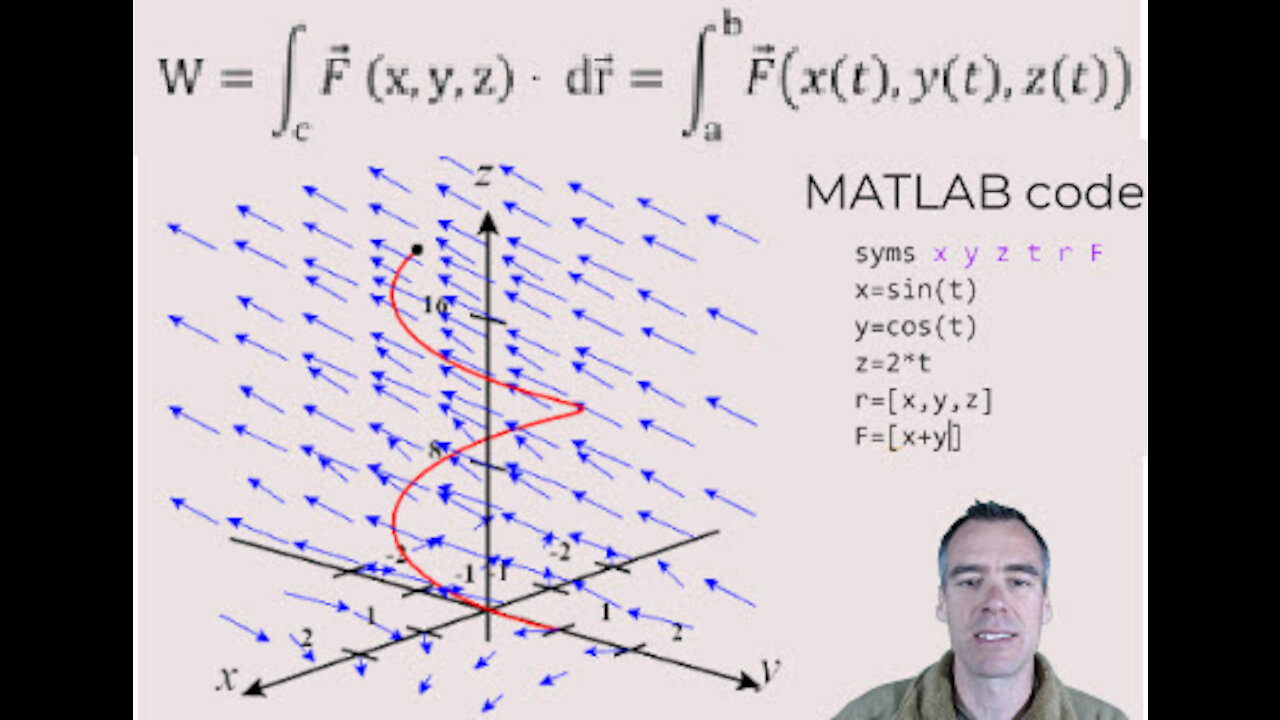Premium Only Content

How to find work done by 3D force field on object in motion
In this video I tackle a seemingly difficult math problem involving vector fields and space curves with a surprisingly easy method using a line integral.
Here’s the problem statement:
Compute the work done by the force field F ⃗(x,y,z)=(x+y) i ̂+(x-z) j ̂+(y+z) k ̂ on a mathematical bug walking along the helix parameterized by r ⃗(t)=〈sin(t),cos(t),2t〉 for 0≤t≤3π.
Ok if this seems rather involved well it is and this only becomes more clear if we take a look at this problem visually to get a handle on it, which you can pull up from the calcplot3d link below
You might imagine it’s rather hard problem to find the work done by this intricate force field on the bug over this convoluted path, but it’s actually pretty straightforward,
We can start off with the equation
And if we parameterize our x and y and z are functions of time, and our dr ⃗ translates into our velocity vector function, r ⃗ ‘(t)dt, and we’re integrating from time a to b.
Now this isn’t too bad, we already have our x, y and z defined above as part of r ⃗(t), and we’re given our a and b as our t range, so we actually have all we need at this point and can just plug into MATLAB
MATLAB
So in MATLAB first we’ll define our variables as usual
syms x y z t r F
then define the x,y and z values given with the provided definition of r ⃗(t)
x=sin(t)
y=cos(t)
z=2*t
then we can define our position function with these x,y and z values
r=[x,y,z]
And finally we can define the force field
F=[x+y,x-z,y+z]
And let’s go ahead and define our a and b limits for good measure
a=0
b=3*pi
Plugging this in we can find our work as the integral of the dot product of our force field F, with the derivative of our position function r wrt t, integrating wrt t for the limits t=a to t=b.
W=int(dot(F,diff(r,t)),t,[a,b])
That answers a bit ugly so we can convert to a decimal
double(ans)
and get ~196.5
And that’s it!
I finally take a look at the problem graphically again to make sure the work done by the force field on the bug is going to be positive, and that solves this seemingly difficult problem with some pretty quick mathematics and the help of MATLAB.
-
 0:29
0:29
GrovenaGrowers
4 years agoField work in the snow!
29 -
 3:46
3:46
Davidtheexplorer
4 years agoOil field work
39 -
 7:08
7:08
THE WORLD OF HOW TO
4 years agoHow to install a defiant motion light
172 -
 0:13
0:13
wejustdecidedto
4 years agoTram Motion
108 -
 3:32
3:32
KTNV
4 years agoWomen are leaving the work force in record numbers
44 -
 0:24
0:24
dad2paisley
4 years ago $0.03 earnedSlo Motion
239 -
 0:19
0:19
jwanshitka
4 years ago $0.02 earnedBird Slow Motion ..
267 -
 0:58
0:58
Slow motion
4 years agoraining slow motion
1221 -
 2:37
2:37
WEWS
4 years agoCleveland pastor says 'God can work through the medical field' to find a COVID-19 vaccine
15 -
 1:27
1:27
KERO
5 years agoAir force plane lands at Meadows Field Airport
54